Don't see the problem, to be honest. Everything is specified and nothing in fine print.To be fair to Klipsch, have you seen the metrics Genelec uses to fudge their max. SPL specs? And that's a highly reputable company. (At least Genelec includes their very specific qualifications in every spec sheet, I guess).
View attachment 86237
-
WANTED: Happy members who like to discuss audio and other topics related to our interest. Desire to learn and share knowledge of science required. There are many reviews of audio hardware and expert members to help answer your questions. Click here to have your audio equipment measured for free!
You are using an out of date browser. It may not display this or other websites correctly.
You should upgrade or use an alternative browser.
You should upgrade or use an alternative browser.
Dutch & Dutch Vs Persona 9H
- Thread starter Manojrc
- Start date
- Joined
- Jun 19, 2018
- Messages
- 6,652
- Likes
- 9,408
@Sancus and @maverickronin I agree, I have little problem with it as long as it is clearly disclosed (and accurate, which in Genelec's case it is).
Having said that, there are numerous standards out there. As an industry, we should be aiming for standardisation in specifying products. Genelec should just tell us how loud their speaker can play by the same standards used by the industry at large. Then we can decide whether it's loud enough for our needs.
I look at Genelec's spec sheets and I have no idea what SPL performance the speaker is capable of below 100Hz. Nor do I know whether that 100Hz-3kHz average they provide is as high as it is because the speaker is relatively linear across this frequency range, or because it can get very loud around 1kHz-3kHz, but can't get very loud below 500Hz (which is in fact the case for this speaker FWIW).
That's not much use, IMHO.
EDIT: sorry @maverickronin - meant to tag @q3cpma! Your avatars got me, lolz
Having said that, there are numerous standards out there. As an industry, we should be aiming for standardisation in specifying products. Genelec should just tell us how loud their speaker can play by the same standards used by the industry at large. Then we can decide whether it's loud enough for our needs.
I look at Genelec's spec sheets and I have no idea what SPL performance the speaker is capable of below 100Hz. Nor do I know whether that 100Hz-3kHz average they provide is as high as it is because the speaker is relatively linear across this frequency range, or because it can get very loud around 1kHz-3kHz, but can't get very loud below 500Hz (which is in fact the case for this speaker FWIW).
That's not much use, IMHO.
EDIT: sorry @maverickronin - meant to tag @q3cpma! Your avatars got me, lolz
Last edited:
I agree, I wish they provided an anechoic SPL@distortion-frequency graph like Neumann does, that would answer all questions and provide an apples to apples comparison.
- Joined
- Jun 5, 2020
- Messages
- 4,809
- Likes
- 3,749
To be fair to Klipsch, have you seen the metrics Genelec uses to fudge their max. SPL specs? And that's a highly reputable company. (At least Genelec includes their very specific qualifications in every spec sheet, I guess).
View attachment 86237
"Ok guys, I know you're all measuring your speakers anechoically, one at a time, and that's cool and all – but we're going to measure our output with two speakers playing, in half space, and only above 100 Hz. Hope y'all are okay with that."
- Joined
- Jan 23, 2020
- Messages
- 4,337
- Likes
- 6,709
"Ok guys, I know you're all measuring your speakers anechoically, one at a time, and that's cool and all – but we're going to measure our output with two speakers playing, in half space, and only above 100 Hz. Hope y'all are okay with that."
I think it's fair to point out that many Genelec customers(pros) only really care about how loud they get as a pair. They have an SPL in mind that they need at a particular listening distance, and they're looking for the Genelec speaker pair that can meet those needs. From that perspective, it makes sense.
It does make it hard to compare to others, though.
- Joined
- Jun 19, 2018
- Messages
- 6,652
- Likes
- 9,408
I think it's fair to point out that many Genelec customers(pros) only really care about how loud they get as a pair. They have an SPL in mind that they need at a particular listening distance, and they're looking for the Genelec speaker pair that can meet those needs. From that perspective, it makes sense.
It does make it hard to compare to others, though.
It's the averaging across a wide frequency band that doesn't make sense IMHO. It obscures the fact that the speakers are relatively limited in the lower midrange (not to mention bass).
The Ones are such a superb speaker, the SPL/distortion limitations of the dual woofers are really the only significant compromise. I just would have liked them to be a bit more upfront about it
To be fair to Klipsch, have you seen the metrics Genelec uses to fudge their max. SPL specs? And that's a highly reputable company. (At least Genelec includes their very specific qualifications in every spec sheet, I guess).
Genelec specs are actually more conservative than they look, so "written by PR department" is barking up the wrong tree.
Show me a measure of peak level that can't be discussed. Even electrical peak level of time-variant signals isn't readily definable, and then we add transducers and a room. The "peak level" spec is there partly for a reader to understand how "short term" SPL is not peak.
Considering "short term" and "long term" specs, they are anechoic measurements, and a conservative room gain is added, based on directivity, to estimate half space. We only use 1-2 dB to estimate half space where others may apply 6 dB.
- Joined
- Jun 19, 2018
- Messages
- 6,652
- Likes
- 9,408
Genelec specs are actually more conservative than they look, so "written by PR department" is barking up the wrong tree.
Show me a measure of peak level that can't be discussed. Even electrical peak level of time-variant signals isn't readily definable, and then we add transducers and a room. The "peak level" spec is there partly for a reader to understand how "short term" SPL is not peak.
Considering "short term" and "long term" specs, they are anechoic measurements, and a conservative room gain is added, based on directivity, to estimate half space. We only use 1-2 dB to estimate half space where others may apply 6 dB.
Thanks for confirming that these are accurate specs and not a PR fantasy. I've mentioned already that I understand the specs to be very accurate.
Perhaps I'm not Genelec's intended customer base but, firstly, I would like to know the speaker's capacity under anechoic conditions so that I can translate that into data about my own listening environment.
Secondly and more importantly, I'd like to know the speaker's capacity where it's at its weakest, i.e. (1) in the bass and (2) in the frequency band above which it would be crossed to a subwoofer. This information is unclear in the specs Genelec publishes because the figures are all averaged across a wide bandwidth (100Hz-3kHz). Although accurate, this is not useful as far as I'm concerned.
If you need a speaker than can produce X decibels under given conditions (either short or long term) when crosses to a sub, for example, you need a speaker that can do that in the 100-300Hz range. It won’t matter that it can do better than that 500-3000Hz if it can’t do it across the whole band (and especially not given the typical spectrum of music).
Anyway, please take this as feedback rather than criticism. I appreciate that Genelec at least gives accurate/conservative information in the specs you do provide, and that you provide a lot more detail than most other manufacturers.
Last edited:
...please take this as feedback rather than criticism. I appreciate that Genelec at least gives accurate/conservative information in the specs you do provide, and that you provide a lot more detail than most other manufacturers.
Thanks for the prudent feedback. We generally produce specs with plenty of detail, e.g. directivity plots in both planes, but this could be a field for improvement. Different genres or applications, however, would have different SPL vs time (i.e. energy) vs frequency requirements, so there should ideally be a graph to illustrate those dimensions coherently.
While I don't think there's any bamboozling going on, the real problem is that the current specs never told us that:Genelec specs are actually more conservative than they look, so "written by PR department" is barking up the wrong tree.
Show me a measure of peak level that can't be discussed. Even electrical peak level of time-variant signals isn't readily definable, and then we add transducers and a room. The "peak level" spec is there partly for a reader to understand how "short term" SPL is not peak.
Considering "short term" and "long term" specs, they are anechoic measurements, and a conservative room gain is added, based on directivity, to estimate half space. We only use 1-2 dB to estimate half space where others may apply 6 dB.
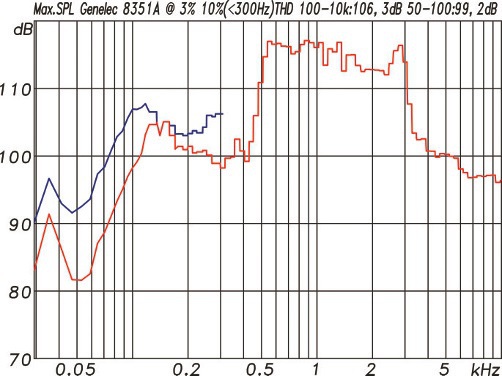
This kind of graph together with the detail per harmonic at some levels (because unweighted sum of harmonics is perceptually as useless as PSNR for images) really is the best. For example, Neumann's specs for the KH420 include these:
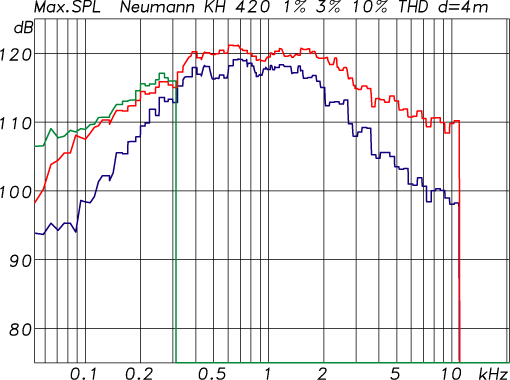
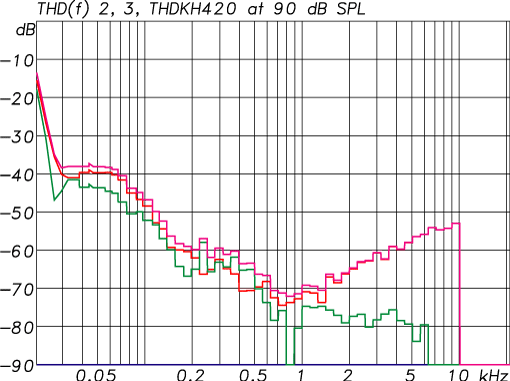
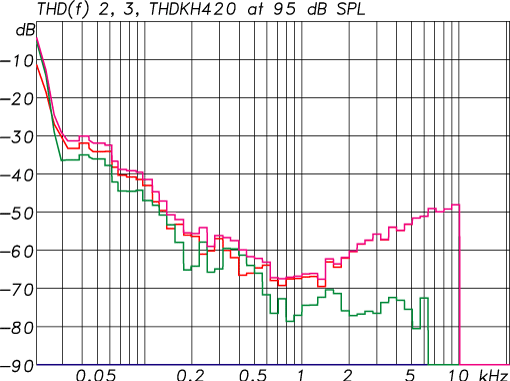
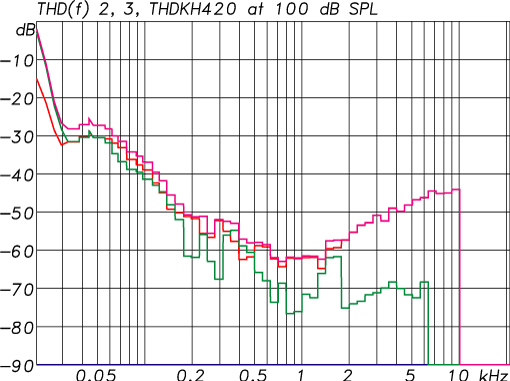
I'd argue that having at least to the 5th harmonic, like Amir does it, would be ideal. SoundAndRecording does include IMD, which is very important and would be nice to see since the Ones uses their MT instead of WT coaxial unit as a whitepaper argument.
While I don't think there's any bamboozling going on, the real problem is that the current specs never told us that ...
In some cases, details may obscure other facts. Regarding Genelec SPL specs, the consistent approach to showing numbers actually makes the newer 8351B look less a performer than it is, compared to 8351A.
Yes, and that's sad. Because the 8351A's woofer was "fixed" and we'd like this to be known for sure.In some cases, details may obscure other facts. Regarding Genelec SPL specs, the consistent approach to showing numbers actually makes the newer 8351B look less a performer than it is, compared to 8351A.
- Joined
- Jun 19, 2018
- Messages
- 6,652
- Likes
- 9,408
Thanks for the prudent feedback. We generally produce specs with plenty of detail, e.g. directivity plots in both planes, but this could be a field for improvement. Different genres or applications, however, would have different SPL vs time (i.e. energy) vs frequency requirements, so there should ideally be a graph to illustrate those dimensions coherently.
Many thanks for the very straight and professional replIes. It’s nice to be listened to. And in general, the detail Genelec provides in its specs and measurements is invaluable. Indeed if the bar wasn’t so high in general, I don’t think I’d even bother mentioning my one gripe with the SPL specs in particular.
Yes, and that's sad. Because the 8351A's woofer was "fixed" and we'd like this to be known for sure.
Well, the forest and the trees. An outstanding coaxial design with excellent directivity in both planes is the forest, and 51A was the groundbreaker. In that respect, other parameters are merely trees
That's indeed the novelty, but such good bass from two "tiny" woofers is also a strong selling point for people considering usage without a subwoofer.Well, the forest and the trees. An outstanding coaxial design with excellent directivity in both planes is the forest, and 51A was the groundbreaker. In that respect, other parameters are merely trees
Geert
Major Contributor
- Joined
- Mar 20, 2020
- Messages
- 1,955
- Likes
- 3,570
For 7.000$/8.400€ per pair that's really terrible. Altough all reviewers seem to conclude it's one of the best speakers ever...
Lorenzo74
Senior Member
Dear All,
My first post here. So please be kind !
I know it may be unfair to compare a speaker against 3 times it’s priced one, but since both share somewhat similar technologies at least when it comes to DSP & room acoustics correction, it’s interesting to see whether it makes sense to pay a lot to get 9H mainly for its floor stand aesthetics & fit and finish. Somehow I’m a big fan, like most of us, of floor standing speakers & I don’t really like the studio monitor look of 8C.
Btw, this comparison is purely for academic purpose, not that I could easily afford both these !
Thank you
-M
I echo @Kal Rubinson 's conclusion that the D&D 8c demonstrates that active, DSP-empowered speakers are the future. And I also echo what I wrote in our original review: "Wow!"—John Atkinson
really need to go further?
Similar threads
- Replies
- 1
- Views
- 569
- Replies
- 3
- Views
- 552
- Replies
- 22
- Views
- 1K
- Replies
- 83
- Views
- 5K

